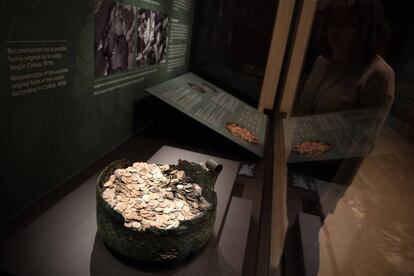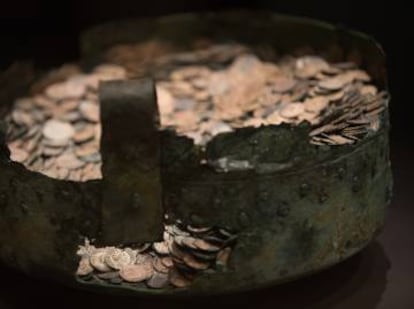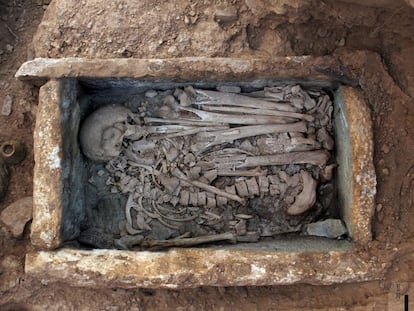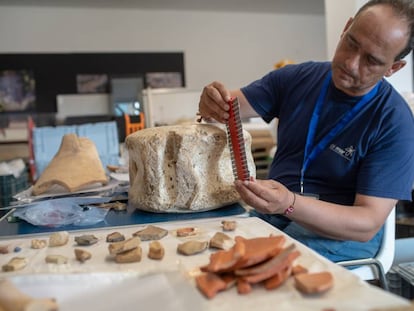How two siblings discovered Roman treasure in Palencia’s countryside
The National Archaeology Museum will return the important find to the northern province next year


In the middle of a torrential storm, the siblings Eusebia and Tomás Roldán traveled up an old path that connected the tiny villages of Valsadornín and Gramedo in Palencia, in northwestern Spain. The rain, which rushed down that wet morning on August 19, 1937, began to reveal an object that looked like an old cauldron at the foot of a wall. Intrigued, the brother and sister moved closer and pulled at its handles with all their strength. It was a copper cauldron, weighing 45 kilograms. Inside there were more than 8,000 fused coins and thousands more were scattered around it. The Roldans had discovered what would from then on be known as the treasure of Valsadornín.
After 67 years, Madrid’s National Archaeology Museum has finished restoring the coins and will return them to Palencia authorities in 2019. According to the director of the Palencia Museum, Francisco Javier Pérez Rodríguez, the thousands of silver and copper coins, acquired during the reign of 18 Roman emperors and empresses, are now ready to be put on permanent display.

Experts agree that the owner of the cauldron hid the treasure due to the instability the Spanish peninsula was experiencing around 270 AD. A study by historian Valentina Calleja highlights that the Spanish-Roman era between 260 and 280 AD was subject to various upheavals from “external and internal causes.” It’s possible the owner hid the treasure with the aim of recovering it once the danger had passed, but never returned.
The cauldron contained around 8,000 coins that were fused together and another 2,421 loose ones. The treasure was handed over to the Palencia Museum, but the siblings did try to sell it beforehand. In fact, according to the reports from that time, the Roldáns “kept some of them.” Locals from Cervera de Pisuerga, a locality close to Valsadornín where the treasure was left for some days, were also reported to have held on to some of the coins. And the governor of Valladolid at that time was given “23 of the best-conserved coins.” The remaining coins, which could not be removed from the cauldron with the technology of the time, were sent to Madrid in 1951 and left to be restored. But decades passed and the treasure remained in the National Archaeological Museum. “There was never time to restore them. Because they were from Palencia …” Pérez Rodríguez complains.
“The treasure of Valsadornín traces a map of power at the time. There are pieces with the names of 18 emperors, empresses and their heirs. It puts a face to the political instability of the empire, with ephemeral leaders and usurpers that succeed and overlap in Rome, Gaul and the East,” explain sources from the National Archaeological Museum.
The thousands of silver and copper coins are now ready to be put on permanent display in Palencia
The oldest coins date back to around 240 AD and the newest to 269 AD. Most were minted in Rome but others were minted as far as Lyon, Antakya and Milan. Almost all were made during the reign of the Roman Emperor Gallienus, who ruled between 253 and 263 AD. Gallienus was emperor during one of most turbulent periods with various rebellions threatening to break up the empire. He was assassinated.
Between 2016 and 2018, the Spanish Institute of Cultural Heritage (IPCE) took charge of restoring the cauldron and the coins, conserving its appearance as close as possible to the original and individually fixing up the coins that were welded together. The team also performed various tests: X-rays, micro-analyses with a scanning electron microscope (SEM) and energy-dispersive X-ray spectroscopies (EDX).
The information from these tests helped them understand what Roman techniques were used to make the coins and the variation of the silver content in these types of pieces. For instance, Antoninus coins, named after the ruling Emperor Marcus Aurelius, were initially made from silver. But as the years passed, they began to lose value because they were made with less silver and more copper and tin.
The coins are currently part of an exhibition at the National Archaeology Museum called Vitrina Cero. But once this closes on January 13, the treasure will be permanently moved back to Palencia Museum. “All security measures will be taken,” assures Pérez Rodríguez.
English version by Melissa Kitson.
Tu suscripción se está usando en otro dispositivo
¿Quieres añadir otro usuario a tu suscripción?
Si continúas leyendo en este dispositivo, no se podrá leer en el otro.
FlechaTu suscripción se está usando en otro dispositivo y solo puedes acceder a EL PAÍS desde un dispositivo a la vez.
Si quieres compartir tu cuenta, cambia tu suscripción a la modalidad Premium, así podrás añadir otro usuario. Cada uno accederá con su propia cuenta de email, lo que os permitirá personalizar vuestra experiencia en EL PAÍS.
¿Tienes una suscripción de empresa? Accede aquí para contratar más cuentas.
En el caso de no saber quién está usando tu cuenta, te recomendamos cambiar tu contraseña aquí.
Si decides continuar compartiendo tu cuenta, este mensaje se mostrará en tu dispositivo y en el de la otra persona que está usando tu cuenta de forma indefinida, afectando a tu experiencia de lectura. Puedes consultar aquí los términos y condiciones de la suscripción digital.
More information
Archived In
Últimas noticias
Rowan Atkinson tops Netflix at 70: ‘He’s as funny as ever’
Israeli recognition of Somaliland stirs up the Gulf
Tiger Woods turns 50: Will he continue playing on the PGA Tour or take a back seat?
The surreal journey of James Nnaji, the Barcelona youth player selected in the NBA Draft who ended up in the NCAA
Most viewed
- Oona Chaplin: ‘I told James Cameron that I was living in a treehouse and starting a permaculture project with a friend’
- Reinhard Genzel, Nobel laureate in physics: ‘One-minute videos will never give you the truth’
- Sinaloa Cartel war is taking its toll on Los Chapitos
- Why the price of coffee has skyrocketed: from Brazilian plantations to specialty coffee houses
- Chevy Chase, the beloved comedian who was a monster off camera: ‘Not everyone hated him, just the people who’ve worked with him’










































